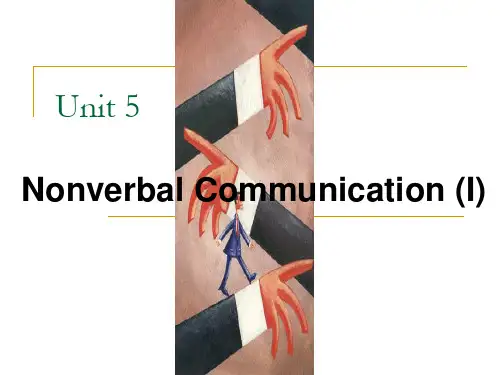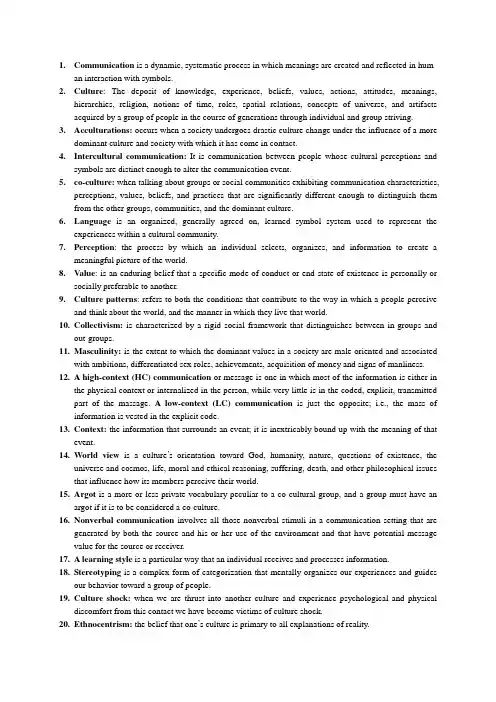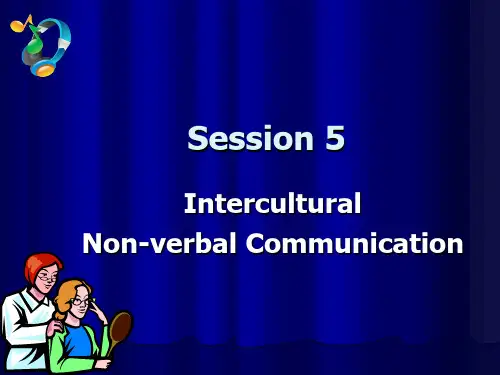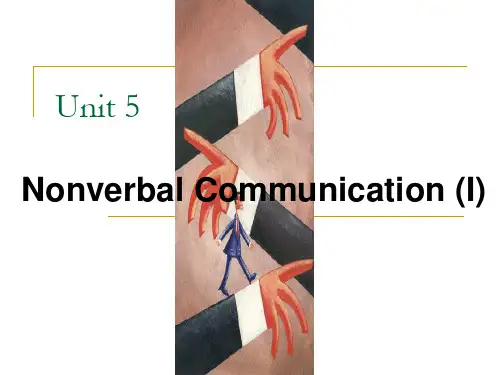跨文化交际英文版5 Nonverbal Communication (I)
- 格式:ppt
- 大小:1.83 MB
- 文档页数:55


munication is a dynamic, systematic process in which meanings are created and reflected in human interaction with symbols.2.Culture: The deposit of knowledge, experience, beliefs, values, actions, attitudes, meanings,hierarchies, religion, notions of time, roles, spatial relations, concepts of universe, and artifacts acquired by a group of people in the course of generations through individual and group striving.3.Acculturations: occurs when a society undergoes drastic culture change under the influence of a moredominant culture and society with which it has come in contact.4.Intercultural communication:It is communication between people whose cultural perceptions andsymbols are distinct enough to alter the communication event.5.co-culture: when talking about groups or social communities exhibiting communication characteristics,perceptions, values, beliefs, and practices that are significantly different enough to distinguish them from the other groups, communities, and the dominant culture.nguage is an organized, generally agreed on, learned symbol system used to represent theexperiences within a cultural community.7.Perception: the process by which an individual selects, organizes, and information to create ameaningful picture of the world.8.Value: is an enduring belief that a specific mode of conduct or end-state of existence is personally orsocially preferable to another.9.Culture patterns: refers to both the conditions that contribute to the way in which a people perceiveand think about the world, and the manner in which they live that world.10.Collectivism:is characterized by a rigid social framework that distinguishes between in-groups andout-groups.11.Masculinity: is the extent to which the dominant values in a society are male oriented and associatedwith ambitions, differentiated sex roles, achievements, acquisition of money and signs of manliness. 12.A high-context (HC) communication or message is one in which most of the information is either inthe physical context or internalized in the person, while very little is in the coded, explicit, transmitted part of the massage. A low-context (LC) communication is just the opposite; i.e., the mass of information is vested in the explicit code.13.Context: the information that surrounds an event; it is inextricably bound up with the meaning of thatevent.14.World view is a culture’s orientation toward God, humanity, nature, questions of existence, theuniverse and cosmos, life, moral and ethical reasoning, suffering, death, and other philosophical issues that influence how its members perceive their world.15.Argot is a more or less private vocabulary peculiar to a co-cultural group, and a group must have anargot if it is to be considered a co-culture.16.Nonverbal communication involves all those nonverbal stimuli in a communication setting that aregenerated by both the source and his or her use of the environment and that have potential message value for the source or receiver.17.A learning style is a particular way that an individual receives and processes information.18.Stereotyping is a complex form of categorization that mentally organizes our experiences and guidesour behavior toward a group of people.19.Culture shock: when we are thrust into another culture and experience psychological and physicaldiscomfort from this contact we have become victims of culture shock.20.Ethnocentrism: the belief that one’s culture is primary to all explanations of reality.21.Seven characteristics of culture affect communication: learned, transmitted from generation togeneration, based on symbols, dynamic, integrated, ethnocentric, adaptive.22.Belief: our conviction in the truth of something. Learned and subject to cultural interpretation andcultural diversity.23.Individualism:refers to the doctrine, spelled out in detail by the seventeenth. The single mostimportant pattern in the US.24.Hofstede’s Value Dimensions:four parts: individualism-collectivism, uncertainty avoidance, powerdistance, and masculinity and femininity.25.Culture differs in their attitudes toward: individualism and collectivism, uncertainty avoidance,power distance, masculinity and femininity, human nature, the perception of nature, time, activity, relationships, context, formality and informality, assertiveness and interpersonal harmony.26.Religious Similarities: sacred writings, authority, traditional rituals, speculation, ethics.27.Five religious orientations: Christianity, Judaism, Islam, Hinduism, Buddhism.28.the family we are born into the family of orientation and take a spouse the family of procreation.29.problems of translation and equivalence:vocabulary or lexical equivalence, idiomatic and slangequivalence, grammatical-syntactical equivalence, experiential-cultural equivalence, conceptual equivalence.30.The use of argot reflects a co-culture’s need to have a language that permits them to 1.sharemembership,2. participate in their social and cultural communities,3. identify themselves and their place in the universe, 4. communicate with one another about their own social realities.31.Functions of communication: repeating, complementing, substituting, regulating, contradicting.32.The study of how movement communicates is called kinesics. Kinesic cues are those visible bodyshifts and movements that can send messages about 1.our attitude toward the other person 2. our emotional state 3. our desire to control our environment.33.Eyes serve six communication functions: 1. indicates degree of attentiveness, interest, and arousal 2.help intiate and sustain intimate relationships 3. influence attitude change and persuasion 4. regulate interaction 5. communicate emotions 6. define power and status relationships 7. assume a central role in impression management.34.kinds of vocalizations: vocal characterizers, vocal qualifiers, vocal segregates.。


Unit 5Nonverbal CommunicationIBC COURSEWARE OF EDWARD ZHANGObectivesI. What is nonverbal communication II. Nonverbal communication and culture III. Functions of nonverbal communication IV. The Importance of Nonverbal Communication V. Nonverbal communication: guidelines andlimitations VI. Categories of Nonverbal CommunicationIBC COURSEWARE OF EDWARD ZHANGIBC COURSEWARE OF EDWARD ZHANGI. Defining nonverbal communication• 1. Nonverbal communication involves all nonverbal stimuli in a communication setting that are generated by both the source and his or her use of the environment and that have potential message value for the source or receiver.• 2. Nonverbal messages may be both intentional and unintentional.IBC COURSEWARE OF EDWARD ZHANGII. Nonverbal communication and culture • 1. Much of our nonverbal behavior, likeculture, tends to be elusive, spontaneous, and frequently beyond our awareness.IBC COURSEWARE OF EDWARD ZHANG• 2. Culture is all-pervasive, multidimensional, and boundless; it is everywhere and in everything. The same is true of nonverbal behavior.IBC COURSEWARE OF EDWARD ZHANG• 3. Another parallel between culture and nonverbal behavior is that both need to be learned.IBC COURSEWARE OF EDWARD ZHANG• 4. Studying nonverbal behavior can lead to the discovery of a culture's underlying attitudes and values. It can also assist us in isolating our own ethnocentrism.IBC COURSEWARE OF EDWARD ZHANGIII. Functions of nonverbal communication • To repeat, complement, substitute for averbal action, regulate, and contradict a communication event.IBC COURSEWARE OF EDWARD ZHANGIV. The importance of nonverbal communication• 1.We make important judgments and decisions about others based on their non-verbal behavior.• 2. We use the actions of others to learn about their affective or emotional states.• 3. Many of our nonverbal actions are not easily controlled consciously.• 4. Nonverbal communication is important to the study of intercultural communication because a great deal of nonverbal behavior speaks a universal language.IBC COURSEWARE OF EDWARD ZHANGV. Nonverbal communication: guidelines and limitations1.It is important to remember that we are all more than our culture.2. In nonverbal communication, we often make differences more important than they should be.3. Nonverbal actions seldom occur in isolation.IBC COURSEWARE OFVI. Categories of Nonverbal Communication•1. Those primarily produced by the body: appearance, movements (kinesics), facial expressions, eye contact, touch.•2. Those the individual combines with the setting: space, time, and silence.IBC COURSEWARE OF2. Body movement (kinesics)•posture•gesturesIBC COURSEWARE OF3. Facial Expressions4. Eye contact and gaze5. TouchIBC COURSEWARE OFIBC COURSEWARE OFhe/she is ready to move at any time. his/her feelings, trying to calm down.•How Body Communicates, from head to toesIBC COURSEWARE OFHEAD-Nodding the head-“Yes”in most societies-“No”in some parts of Greece, Yugoslavia, Bulgaria, and Turkey•Tossing the head backward–“yes”in Thailand, the Philippines, India, LaosIBC COURSEWARE OFFACE IBC COURSEWARE OFIBC COURSEWARE OFEYES*Eye contacts-Encouraged in America, Canada, Europe-Rude in most Asian countries and in Africa*Winking eye-Sharing secret in America and Europe-flirtatious gesture in other countries*Closed eyes-bored or sleepy in America-“I’m listening and concentrating.”in Japan, Thailand, ChinaIBC COURSEWARE OFEars*Ear grasp-“I’m sorry.”in parts of India*Cupping the ear-“I can’t hear you.”in all societies*Pulling ear-“You are in my heart”for Navajo IndiansIBC COURSEWARE OFIBC COURSEWARE OFLIPS AND MOUTHCheeks*Cheek screw-gesture of praise -Italy-“That’s crazy.”Germany*Cheek stroke-“pretty, attractive, success”most EuropeIBC COURSEWARE OFTHE LIP POINTING*Kiss. In parts of Asia, kissing is considered an intimate sexual act and not permissible in public, even as a social greeting.IBC COURSEWARE OFTHE LIP POINTING •Finger tip kiss. In France, it conveys several messages, “That’s good!”“That’s great!”“That’s beautiful!.”IBC COURSEWARE OFIBC COURSEWARE OFTHE LIP POINTING*Open mouth. Any display of the open mouth is considered very rude in mostcountries.Fingers*The “O.K.”signal. (the thumb and forefinger form a circle) means*“fine,”or “O.K.”in most cultures,*“zero”or “worthless”in some parts ofEurope*“money”in Japan*an insult in Greece, Brazil, Italy, Turkey,Russia and some other countriesIBC COURSEWARE OFFingers*Pointing.*Pointing with the index finger iscommon in North America andEurope.*But it is considered impolite inJapan and China where theyfavor using the whole open hand.*Malaysians prefer pointing withthe thumb.IBC COURSEWARE OFIBC COURSEWARE OFHands*Of all the body parts, thehands are probably used most for communicating non-verbally.*Hand waves are used for greetings, beckoning, orfarewells.Hands*The Italian“good-bye”wave can be interpreted by Americans as the gesture of “come here.”*The American “good-bye”wave can be interpreted in many parts of Europe and Latin America as the signal for “no.”IBC COURSEWARE OFHands*Handshaking is a form of greeting in most Western cultures.*In the Middle East, a gentlegrip is appropriate.*In most Asian cultures, a gentlegrip and an avoidance of directeye contact is appropriate.IBC COURSEWARE OFHands*Right hand. The right hand has special significance in many societies. In certain countries in the Middle East and in Asia, it is best to present business cards or gifts, or to pass dishes of food, to get an attention, using only the right hand or both. *Left hand is considered unclean in much of the Middle East and in parts of Indonesia.IBC COURSEWARE OFHands*Clapping hands.*Russians and Chinese may use applause to greet someone.*In many central and eastern Europe,audience frequently clap in rhythm.IBC COURSEWARE OFNose*Holding the nose-“Something smells bad.”universal *Nose tap-“It’s confidential.”England-“Watch out!”or "Be careful.”ItalyIBC COURSEWARE OFIBC COURSEWARE OFNose*Pointing to nose-“It ’s me.”China*Blowing nose-In most Asian countries , blowing the nose at social gathering is ‘disgusting.’Arms*Some cultures, like the Italians, use thearms freely. Others, like the Japanese,are more reserved; it is considered impolite to gesticulate with broadmovements of the arms.*Folding arms are interpreted by somesocial observers as a form of excluding self, “I am taking a defensive posture,”or“I disagree with what I am hearing.”IBC COURSEWARE OF*Arms akimbo. In many cultures, thisstance signals aggression, resistance, impatience, or even anger.*Arms behind back, hands grasped is a sign of ease and control.*Arms in front, hands grasped, common practice in most Asian countries, is a sign of mutual respect for others.IBC COURSEWARE OFIBC COURSEWARE OFLegs & Feet*In Asia, do not point with your toes.*In Asia and some European countries, putting feet up on a desk or any other piece of furniture is very disrespectful.*Sitting cross-legged, while common in North America and some European countries, is very impolite in other parts of the world.IBC COURSEWARE OFCase Study•Study the following three cases and explain what messages smiles and laughter usually convey.IBC COURSEWARE OFCase Study1. In a Chinese classroom a girl was asked to answer a question. She stood up and smiled, without making any sound.2. When an American is parking his bicycle and the bicycle accidentally fall over, he feels embarrassed at his awkwardness, and is quite angered and humiliated when Chinese onlookers laugh.3. In the dining room, when an American drops a plate quite by accident and feels bad, and Chinese onlookers laugh, compounding his discomfort and causing anger and bad feelingIBC COURSEWARE OFSmile and laughter•Smile and laughter usually convey friendliness, approval, satisfaction, pleasure, joy and merriment.•In case A, the girl smiled to cover her embarrassment resulting from not being able to answer the question.•In case B and C, the laughter is not at the person or his misfortune –whether he is aIBC COURSEWARE OFSmile and laughter foreigner or a Chinese. It can convey a number of feelings: don’t take it so seriously; laugh it off, it’s nothing’such things can happen to any of us.IBC COURSEWARE OFSpace and Distance •Space includes the personal space and territoriality.•Animals and human beings both stake out to defend their territories.•The territorial invasion of a country may lead to the declaration of war. But people as individuals may not be so pugnacious (好斗的).• A more tangible form of communication between people is the use and control of space.IBC COURSEWARE OFNorth Americans’distance habit0~45cm:intimate lovers and family members45~80cm:friends (personal distance)130~300cm:acquaintances (social distance)>270cm:public space, not belong to oneself Behind:strangers speaking from behind are allowed to stand much more nearer.IBC COURSEWARE OFSpace and Distance•Personal spaceEdward T. Hall suggests that “each person has around him an invisible bubble of space which expands and contracts depending on his relationship to those around him, his emotional state, and the activity he is performing.”Based on his observations of North Americans, Hall developed four categories of distance in human interactions:IBC COURSEWARE OF•(1) Intimate distance: ranging from body contact to 18 inches, this distance is used for personal contact, comforting, and protecting.** 一英寸=2.54厘米IBC COURSEWARE OF•(2) Personal distance: from 18 inches to 4 feet, depending on the closeness of the relationship, in this distancing mode people have an visible “space bubble”separating themselves from others.** 1英尺(ft)=0.3048米(m)IBC COURSEWARE OF•(3) Social distance: from 4 to 12 feet, this distance is used by acquaintances and strangers in business meetings and classrooms.IBC COURSEWARE OF。



跨文化交际的英文作文English:Cross-cultural communication is an essential aspect of our globalized world. It involves interactions between people from different cultural backgrounds, where language, customs, beliefs, and norms can vary significantly. Successfully navigating these interactions requires understanding, respect, and adaptability.One significant challenge in cross-cultural communication is language barriers. For instance, during my travels in China, I encountered a situation where Istruggled to convey my dietary restrictions to a local chef. In English, I requested a vegetarian dish, assuming itwould be understood. However, the chef seemed perplexed,and I realized my mistake. I then tried using basic Mandarin phrases I had learned, such as "wǒ bù chī ròu" (我不吃肉), meaning "I don't eat meat." This helped bridge the communication gap, and the chef was able to prepare asuitable meal.Another aspect to consider is non-verbal communication. In many cultures, gestures, facial expressions, and body language convey meanings as much as words do. For example, a firm handshake is often seen as a sign of confidence and respect in Western cultures. However, in some Asian cultures, a softer handshake may be more appropriate, as a firm grip can be perceived as aggressive. Understanding these nuances is crucial for building rapport and avoiding misunderstandings.Moreover, cultural differences in communication styles can lead to misunderstandings. For instance, in some cultures, direct communication is valued, while in others, indirect communication is preferred to maintain harmony. During a business negotiation in Japan, I found that my straightforward approach was met with silence and nods, which I initially interpreted as agreement. However, upon reflection, I realized that my Japanese counterparts were being polite and non-confrontational, and their silence indicated they were considering my proposal rather thanagreeing outright.In conclusion, effective cross-cultural communication requires patience, empathy, and an open mind. Byrecognizing and respecting cultural differences in language, non-verbal cues, and communication styles, we can foster mutual understanding and build stronger relationshipsacross borders.中文:跨文化交际是我们全球化世界中至关重要的一部分。


Unit 5Nonverbal communication课前谚语+名言:1、I’s not what he said, but the way he said it.——English saying2、There is a language in her eyes, her cheeks, her lips.——William Shakespeare案例一:个人空间马克最近从丹麦搬到了悉尼,在一家澳大利亚公司当销售员。
他被邀请加入当地的一个俱乐部。
有一天在一个晚会上,一个女成员走近他,马克立即通过谈论展现出了他的兴趣。
起初聊天进行的很顺利,但随着谈话的进行,马克逐渐的向她靠近,而那位女士似乎离他越来越远,并显得很不自在。
当马克正要问她有关于澳大利亚习俗的问题时,站在旁边的一个男士往这边瞟了一眼,她找了个借口离开,去和那个男人说话。
留下马克傻傻的站在那里,他不知道为什么他们的交谈如此突然地停止了。
Question:Why did that women suddenly stop talking with mark and turned to another man?注释:这是一个对身体距离理解不同造成的误会。
在丹麦,正式场合中,个人空间大概在20厘米-30厘米之间。
而在澳大利亚,这样的场合需要40厘米-50厘米的身体距离。
所以丹麦人习惯近距离交谈,澳大利亚人习惯远距离交谈。
在这个情况下,马克尝试去建立自己正常的个人亲密空间,侵犯了澳大利亚女士的空间,正因如此,她感到了某种威胁,失去了舒适感。
就在那时,身旁的男人给了她一个离开的机会。
如果马克对于澳大利亚人所期待的个人空间有所了解的话,或许这个谈话会有所不同。
案例二:使用当地语言的问题。
弗兰克为了做研究的目的从澳大利亚来到中国,为此,他在大学里刻苦学习中文,并且能用中文很方便的和人交流。
而当他到达北京以后,他开始和当地人交谈,询问方向和建议。
尽管他几乎都是用中文和他们交流,但是他发现周围的人有时候会笑着用英语回答他,尽管他们对英语知之甚少。

